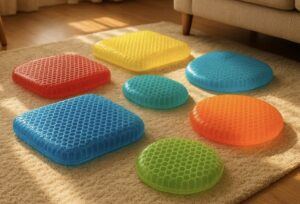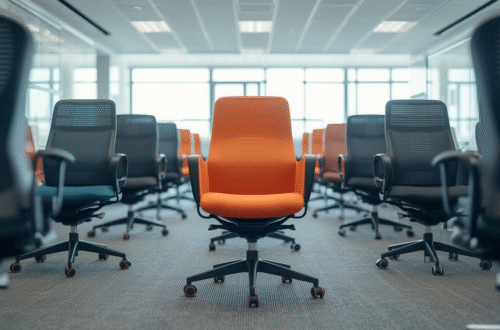If you’ve ever spent a long day in a stiff chair, whether at a desk, at home, or in the car, you already know that comfort can make or break your mood. Adding a seat cushion is one of those simple tricks that can turn just about any chair into a spot you can enjoy for hours. I’ve found that a good seat cushion isn’t just about softness; it’s also about helping your back, hips, and posture stay happy, whether you’re working, gaming, or watching TV so using seat cushions for extra comfortable chairs is a must!

Why Adding a Seat Cushion to Your Chair Makes a Difference
A seat cushion might look like just another accessory, but it’s actually pretty handy for boosting comfort and support. Most standard chairs are built for anyone, but that also means they’re truly a perfect fit for almost no one. Seat cushions let you fine-tune your setup and turn even a cheap or rigid chair into something that works better for your body.
Most seat cushions, especially those made with memory foam or gel, help distribute your weight more evenly. This takes pressure off your tailbone and hips, which is a major plus if you sit for long stretches.
I’ve noticed a big difference during long office days when swapping a hard chair for a chair and cushion combo. My legs don’t get that numb feeling, and I don’t find myself squirming every twenty minutes trying to get settled.
When it comes to making a chair seat more comfortable, I start by looking at what’s missing. Most discomfort comes from lack of support or not enough padding in the seat and back. Adding a seat cushion basically patches up those problems fast.
Some people go further by layering cushions—one for the seat, another for the back—or by grabbing an ergonomic cushion with cutouts for the tailbone or extra lumbar support. Any of these upgrades can turn a standard chair into something far more cushy and supportive.
Types of Seat Cushions and Their Benefits
Not every cushion is built the same, so picking one that matches your needs can really pay off. Here are some of the different styles people often choose for extra chair comfort:
- Memory Foam Cushions: Mold to your body shape and provide steady support. These are great if you need to reduce pressure points on the hips or lower back.
- Gel Cushions: Distribute heat well, so if you run warm or sit for ages, you’ll love how these keep things cool and even.
- Orthopedic and Ergonomic Cushions: Designed to reduce strain on the spine and tailbone, these usually have special contours and cutouts that make a difference if you deal with back pain.
- Inflatable Cushions: Handy and easy to carry around, which is useful for travelers or if you move between different chairs often.
- Donut Cushions: Good for folks dealing with coccyx discomfort or recovery after certain surgeries. They spread weight away from sensitive spots.
Choosing the right type often comes down to personal preference. Some people want plush softness, while others need firmer support. Reading up on product reviews or checking ratings on brands like Purple, Everlasting Comfort, or Tempur Pedic can help you make a good choice.
The best part is, once you stumble upon the right cushion, it turns any old seat into a spot you actually want to use all day.
Beyond those core types, some cushions are made with advanced cooling technology, while others offer built-in vibration for massage. Some are shaped for wheelchairs, and others are designed for stadium seats or drivers who need extra road trip comfort.
If you have specific concerns like sciatica or hip pain, brands often list which conditions their cushions are meant for, so be sure to skim those details before buying.
Do Seat Cushions Really Make A Difference?
This is one of those things I didn’t totally buy into until I tried it. Yes, seat cushions can absolutely make a huge difference, especially if you sit for hours at a time. The biggest benefit is pretty simple: more even weight distribution and a much higher comfort level.
If a chair feels too hard, you’re likely to fidget, lean, or cross your legs, none of which are great for your spine in the long run.
I’ve noticed that, on days I use a cushion, I’m less likely to slump or tuck my legs under me. My posture naturally stays better, even when I get caught up in work or gaming.
There’s actually some published research on the benefits of ergonomic seating—cushions designed for pressure relief have been shown to help tone down discomfort and fatigue during prolonged sitting (source).
This is especially noticeable for people who experience tailbone pain, lower back soreness, or sciatica symptoms.
A seat cushion isn’t a magic fix for a bad chair, but it’s a simple step that makes any seat comfier and more supportive. I see it as an easy upgrade, not just for comfort, but for a little extra physical self-care.
How To Make a Chair Seat Even More Comfortable
There’s more than one way to use a seat cushion for optimal comfort. Here are some easy tricks I use to make just about any seat cozier:
- Choose the Right Cushion: Go for high density memory foam or a gel style cushion with a nonslip base. The right material and size will make a world of difference.
- Add a Back Cushion: Pair your seat cushion with a lumbar pillow for full back support. It helps keep your posture good during long hours.
- Adjust the Chair Height: Stack or adjust cushions to get your hips level with your knees, keeping your feet flat on the floor. This keeps your spine in a neutral position and lessens strain.
- Secure Your Cushion in Place: Look for cushions with straps or grips on the underside so you’re not sliding around as you move.
- Use Breathable Covers: Swap in a washable, breathable cover to keep things fresh and to avoid that sticky, synthetic feel some cushions can have in hot weather.
If a cushion feels too firm or sits too high, you can trim it to size or stack a thinner pad over a firmer base for custom support. A bit of trial and error is normal until you figure out what feels perfect for your chair and your body.
It’s also worth noting that moving around or taking breaks is still important, even with the best seat setup. Stand up regularly, walk around the room, or stretch so your body doesn’t stiffen up. Seat cushions give a boost to comfortable sitting, but a little movement helps keep discomfort away too.
Do Seat Cushions Help With Back Pain?
This is a question I get a lot. In my experience, and from what I’ve read in medical advice, seat cushions can help reduce or prevent some types of back pain, especially if the pain is caused by sitting badly for long stretches.
Cushions designed with ergonomic support relieve pressure at the tailbone (coccyx) and lower spine. Over time, this can lessen muscle stress and help encourage better posture habits.
If you deal with chronic or persistent back pain, pairing a quality seat cushion with proper ergonomic habits makes a pretty solid combo. That means sitting back in the chair, keeping both feet flat on the ground, and making sure screens are at eye level. Cushions help with alignment but work even better if you remember healthy posture basics. 
Of course, if your pain lingers or gets worse, it’s always smart to check in with a healthcare pro. Some issues might need more targeted solutions. But for most everyday aches caused by less-than-ideal chairs or poor posture, a seat cushion can take the edge off and make sitting for long periods less of a strain.
What To Watch For When Buying a Seat Cushion
It’s pretty tempting to just buy the first cushion you see on sale, but a little research makes all the difference. Here are a few practical things worth checking out before you pick a cushion:
- Material Quality: Look for durable memory foam, gelinfused cores, or latex for a balance of support and comfort. Cheaper cushions often lose their shape or break down quickly.
- Cushion Shape: Contoured and wedge shaped cushions can offer extra relief for folks with back or hip issues. Some even have cutouts for added tailbone comfort.
- Nonslip Base: If your cushion slides around, you’ll be fussing with it all day, which is pretty annoying.
- Washable Cover: Machine washable covers keep things clean and fresh for daily use.
- Size: Make sure the cushion fits your chair. A cushion that hangs over the sides or is too narrow won’t feel quite right.
Spending a little more on a cushion that’s actually comfortable to sit on for hours is worth it in the long run. Reading honest user reviews or checking out test results from places like Wirecutter or Sleep Foundation can help you spot the real winners.
Seat Cushion Hacks and Advanced Comfort Upgrades
Once you get used to your cushion, you can get a bit creative with your setup. Here are some favorite hacks people swear by:
- Double Up: For hard chairs, layer a basic pad with a more supportive memory foam topper so you get softness and support.
- Portable Support: Grab a foldable or travelsize cushion to use in the car, on airplane seats, or at restaurants.
- Heated Cushions: For chilly offices or home setups, a heated cushion can help melt away low back tension on cold days.
- Ergonomic Footrest: Add a footrest with your seat cushion to keep circulation moving and prevent leg fatigue. This little upgrade makes a big difference for extended sitting.
These tweaks aren’t just about luxury; they really help with aches, restless legs, and back soreness from being stuck in one position too long.
Frequently Asked Questions About Seat Cushions
How can I make a chair seat more comfortable?
Start by adding a high density seat cushion, and if needed, a lumbar support pillow. Adjust your chair height and add a breathable cover for all day comfort.
Do seat cushions really make a difference?
They absolutely do, especially for longer sitting sessions. Seat cushions distribute weight, support your spine, and encourage more natural posture.
How can I make a seat cushion even more comfortable?
Layer a soft, ventilated cover, and make sure it’s the right thickness for your chair. Try adding a back support or pairing with a footrest for the ultimate setup.
Do seat cushions help with back pain?
Cushions designed for ergonomic support often help reduce back pain by easing pressure and supporting better alignment. Remember, however, that back pain can have many causes, and if discomfort continues, checking with a healthcare provider is worthwhile.
Chair Comfort is Just a Cushion Away
Finding the right seat cushion can really transform your chair and the way you feel after a busy day. With a bit of trial and error and some attention to quality, almost any seat can become the comfy spot you look forward to at the end or even the beginning of every day.
If you want to step up your seating situation, try a few different cushion types and combo setups until you stumble upon what matches your comfort needs perfectly. Happy sitting!
Thanks for stopping by and hope you enjoyed reading all about using seat cushions for extra comfortable chairs!
Have a great day!



